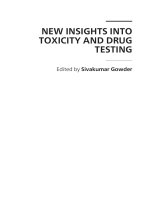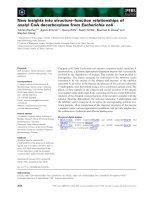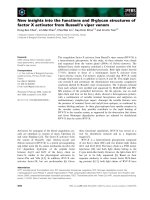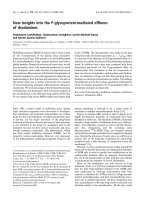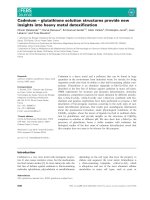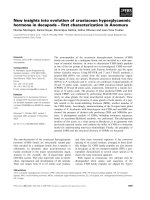New insights into crystallization from thermodynamics to polymorphism and kinetic
Bạn đang xem bản rút gọn của tài liệu. Xem và tải ngay bản đầy đủ của tài liệu tại đây (1.31 MB, 214 trang )
NEW INSIGHTS INTO CRYSTALLIZATION:
FROM THERMODYNAMICS TO POLYMORPHISM AND KINETICS
HAN GUANGJUN
M. ENG., NUS, SINGAPORE
A THESIS SUBMITTED FOR
THE DEGREE OF DOCTOR OF PHILOSOPHY
DEPARTMENT OF CHEMICAL & BIOMOLECULAR
ENGINEERING
NATIONAL UNIVERISTY OF SINGAPORE
2007
Acknowledgements
With deep sense of gratitude and profound respect, I sincerely thank my
supervisor Prof Reginald B. H. Tan. His resourcefulness, enthusiasm, professional
guidance and excellent supervision created a very favorable environment for my research
work and got me increasingly interested in the research. Such an encouraging
environment definitely inspired me to come out with new ideas one after another, which
accounted for the great success of the challenging research in a broad area covering
thermodynamics, polymorphs and kinetics of crystallization. Indeed, it was an important
and enriching experience under his supervision that had positive and significant effects
on my career development.
I would like to thank my former colleagues Mdm Li Xiang and Mdm Li Fengmei
(the Dept of Chemical and Biomolecular Eng, NUS) for supporting my job and my
research. Without their assistance, my research work would not have been done that
efficiently.
I am thankful to the following undergraduate students for their assistance with
some of my experimental and numerical work during the period of carrying out their
Final Year Projects: Tian Fanghui, Ang Yixuan, Ng Suat Ling Vivien, Ng Wei Jun Andy,
Heng Wei Jie, Chen Sue Ann, Ong Shu Ling, Han Yong Yuan, Ang Yong Wei, Leong
II
Guorong, Kwan Li Min Beatrice, Wu Xinpei, Lim Lihua Charlotte, Teo Lizhu, Zheng Zi
Jian, Ng Boon Foong, Lee Syin Dee, Ong Geok Hoon and Ng Huiting.
I am grateful to Dr Yu Zaiqun (Institute of Chemical and Engineering Sciences,
Singapore). The discussion with him about the crystal growth kinetics and its
experimental measurement was very useful, which helped me carry out the project of
kinetics more efficiently.
As a part-time PhD candidate, weekends and public holidays were often the time
for me to do the research. Without the full support of my family, it would not have been
possible for me to complete my PhD study. Dedicating this thesis to my wife Zeng
Yingzhi is a minor recognition of her full support, great encouragement, taking good care
of my sons and assuming housekeeping while she did a full-time research work with
IHPC (Institute of High Performance Computations).
III
Table of Contents
Acknowledgement II
Summary VII
List of Tables IX
List of Figures XI
Nomenclature XIV
Chapter 1 Introduction 1
Chapter 2 Literature Review 10
2.1 Experimental Methods for Thermodynamic Activity 10
2.2 Crystal Polymorphism 21
2.3 Kinetics of Crystal Growth 35
Chapter 3 A New Technique for Activity of Supersatuarted Solutions 44
3.1 Development of A New Technique 44
3.1.1 Theory of Potentiometric Method 45
3.1.2 Effects of Transport Phenomena and Temperature 49
on Cell Potential
3.1.3 The Proposed Steady State Shifting Technique 50
3.2 Materials and Instruments 53
3.3 Experimental Verification of the Proposed Technique 56
3.4 Results and Discussion 60
IV
3.4.1 Activities for Ternary Solutions 61
3.4.2 Derivation of Activities for Binary Supersaturated 75
Nonelectrolyte Solutions
3.4.2.1 Fundamental Analysis 76
3.4.2.2 Activities of Binary Nonelectrolyte+H
2
O Solutions 79
3.5 Summary 85
Chapter 4 Analysis of Solution Chemistry, Thermodynamics and Molecular
Interaction for NaCl+Amino Acid+H
2
O Solutions 87
4.1 Detailed Experimental Observations 88
4.2 Solution Chemistry, Molecular Interaction and Complex Formation 91
4.3 Interpretation of the Observed Thermodynamic Activities 93
4.3.1 Salting Effect of an Amino Acid on NaCl 94
4.3.2 Salting Effect of NaCl on Amino Acids 99
4.4 A Preliminary Insight into Glycine Polymorphs and Growth Kinetics 102
4.5 Summary 106
Chapter 5 Impact of an Electrolyte on Glycine Polymorphs 107
5.1 Background of Glycine Polymorphs from Electrolyte Solutions 107
5.2 Experimental Section 109
5.2.1 Experimental Materials 109
5.2.2 Experimental Procedure 110
5.3 Results and Discussion 112
5.3.1 Solubility 112
V
5.3.2 Glycine Polymorphs 117
5.3.2.1 Glycine Polymorphs from 1:1 Electrolyte Solutions 118
5.3.2.2 Glycine Polymorph from 1:2 Electrolyte Solutions 128
5.3.2.3 Glycine Polymorph from 2:1 Electrolyte Solutions 132
5.3.2.4 Glycine Polymorph from 2:2 Electrolyte Solutions 136
5.4 Summary 139
Chapter 6 Effects of Electrolytes on Kinetics of γ-glycine Growth 141
6.1 Experimental Materials 141
6.2 Experimental Procedure 143
6.3 Evaluation of the Method for γ-glycine Kinetic Study 145
6.4 Effects of Different Electrolytes on γ-glycine Growth Rate 150
6.5 Effects of Electrolyte Concentration 160
6.6 Summary 165
Chapter 7 Conclusions and Recommendations 166
7.1 Conclusions 166
7.2 Recommendations 169
References 171
Appendix A Solubility Test 192
VI
Summary
In this study, a new and simple technique, namely Steady State Shifting
Technique, has been developed to overcome the difficulty in measuring thermodynamic
activity for supersaturated electrolyte-containing solutions to provide an in-depth insight
into crystallization. The successful application of the proposed technique to
thermodynamic studies of a few ternary electrolyte+nonelectrolyte+H
2
O systems has
been demonstrated, in a wide range of solution concentrations from dilute up to the onset
of nucleation. New thermodynamic data in the supersaturated region were obtained and
interesting phenomena were found. The supersaturated activity data enabled the good
thermodynamic consistency between activity and solubility to be confirmed. With the
activity data for the ternary systems and solubility data of the nonelectrolytes, activity
data for binary supersaturated nonelectrolyte aqueous solutions were derived. It is
expected that the new technique can be applicable to many other systems, based on the
experimental framework established in this study.
The obtained activity data, particularly those for NaCl+glycine+H
2
O, were well
analyzed and interpreted by the proposed molecular interaction and the formation of
different ion-glycine complexes. More importantly, the analysis implied that the
introduction of univalent ions (e.g. Na
+
and Cl
−
) from a 1:1 electrolyte would
significantly disrupt the formation of glycine cyclic dimers which are building units of α-
glycine polymorph, while it would generate building units (singly-charged ion-glycine
complexes) of γ-glycine polymorph. Therefore, it would be a general phenomenon that
VII
univalent ions inhibit α-glycine and promote γ-glycine. This naturally led to the
systematic exploration of the impacts of different electrolytes on glycine polymorphs.
The experimental investigation of glycine polymorphs formed from different
electrolyte solutions revealed an interesting pattern: 1:1 (e.g. KCl) and 1:2 (e.g.
(NH
4
)
2
SO
4
) electrolytes substantially inhibit α-glycine and promote γ-glycine, while 2:1
(e.g. CaCl
2
) and 2:2 (e.g. MgSO4) electrolytes have a higher tendency to induce α-
glycine. The mechanisms have been proposed based on molecular interaction, ion-
glycine complex formation and chemistries of glycine polymorphs. They suggested that
the valence(s), rather than other properties of the ions from an electrolyte primarily
determine the outcome of glycine polymorphs formed from electrolyte solutions, as the
valences of electrolyte ions affect the formation of ion-glycine complexes and they
eventually exert substantial impacts on the anisotropic growth rates from the facets of
polymorphic glycine nuclei. It was then logical to quantify glycine crystal growth rates
from electrolyte solutions.
The kinetic study of γ-glycine crystals from different electrolyte solutions has
been done using a batch isothermal crystallizer. As it can be expected, 1:1 and 1:2
electrolytes tremendously enhance the growth rates of γ-glycine crystals, while 2:1 and
2:2 electrolytes have a much weaker influence on the enhancement of γ-glycine growth.
Though different ions affect the growing faces of γ-glycine crystals differently, the
obtained kinetic data lend additional support to the mechanisms proposed for glycine
polymorphs from electrolyte solutions.
VIII
List of Tables
Table 3-3-1 Cell potential comparison between the conventional and the proposed
technique at 25 °C 57
Table 3-4-1 Values of correlation parameters (A toT in Eq. 3-4-1) for NaCl activity
coefficient ratios
I
II
±
±
γ
γ
in NaCl+nonelectrolyte+H
2
O solutions at 25 °C 65
Table 3-4-2 Solubilities of γ-glycine, DL-serine and DL-alanine in different NaCl
solutions at 25 °C 70
Table 5-3-1 α- and γ-glycine solubilities (g/100g H
2
O) in NaCl, NaNO
3
, KCl and KNO
3
solutions at 25 °C 113
Table 5-3-2 α- and γ-glycine solubilities (g/100g H
2
O) in NH
4
Cl, NH
4
NO
3
, NH
4
Ac and
NaHCO
3
solutions at 25 °C 114
Table 5-3-3 α- and γ-glycine solubilities (g/100g H
2
O) in Na
2
SO
4
, K
2
SO
4
and (NH
4
)
2
SO
4
solutions at 25 °C 114
Table 5-3-4 α- and γ-glycine solubilities (g/100g) in Na
2
CO
3
, CaCl
2
, MgSO
4
and
Ca(NO
3
)
2
solutions at 25 °C 115
Table 5-3-5 Glycine polymorphs from 1:1 electrolyte solutions, by forced cooling 119
Table 5-3-6 Glycine polymorphs from 1:1 electrolyte solutions,
by both modes of cooling 126
Table 5-3-7 Glycine polymorphs from 1:2 electrolyte solutions, by cooling 128
Table 5-3-8 Glycine polymorphs from 2:1 electrolyte solutions, by cooling 133
Table 5-3-9 Glycine polymorphs from 2:2 electrolyte solutions, by cooling 136
Table 6-3-1 Experimental data of γ-glycine growth from pure H
2
O at 25°C 146
Table 6-3-2 Experimental data of γ-glycine growth from 2.5m NaCl solution at 25°C 146
Table 6-4-1 Mass increment of γ-glycine seeds in the first time interval of seed growth
from various electrolyte solutions at 25°C 151
Table 6-4-2 Values of parameters of power law ln(R
G
) = g*ln(σ) + ln(k
g
) for γ-glycine
growth from different electrolyte solutions 155
IX
Table 6-4-3 γ-glycine growth rate R
G
from various electrolyte solutions at 25°C 156
Table 6-5-1 Mass increment of γ-glycine seeds in the first time interval of seed growth
from various NaCl solutions at 25 °C 161
Table 6-5-2 Values of parameters of power law ln(R
G
) = g*ln(σ) + ln(k
g
) for γ-glycine
growth from various NaCl solutions 161
Table 6-5-3 γ-glycine growth rate R
G
from various NaCl solutions at 25 °C 162
X
List of Figures
Figure 2-2-1 Schematic structure of a centrosymmetric α-glycine crystal built with
elementary cyclic dimers (Towler et al., 2004) 26
Figure 2-2-2 Schematic structure of a γ-glycine crystal with polar ends [c-axis NH
3
+
rich,
slow growing end (+c) and the COO
−
rich, fast growing end (-c). Towler et
al., 2004] 27
Figure 3-2-1 Schematic diagram of the experimental setup 54
Figure 3-3-1 Cell potentials by the two techniques for the same under-saturated solution
of (3.0m glycine + 0.01m NaCl) 58
Figure 3-3-2 A typical cell potential measurement on a supersaturated solution of (4.2m
glycine + 2.5m NaCl), using the steady state shifting technique 60
Figure 3-4-1 Calibration of Na-ISE vs Cl-ISE at 25 °C 61
Figure 3-4-2 Effects of glycine and NaCl concentrations on NaCl mean ionic activity
coefficient ratio
I
II
±
±
γ
γ
at 25 °C 62
Figure 3-4-3 Effects of DL-serine and NaCl concentrations on NaCl mean ionic activity
coefficient ratio
I
II
±
±
γ
γ
at 25 °C 63
Figure 3-4-4 Effects of DL-alanine and NaCl concentrations on NaCl mean ionic activity
coefficient ratio
I
II
±
±
γ
γ
at 25 °C 63
Figure 3-4-5 Effect of glycine and NaCl concentrations on glycine activity coefficient
ratio
I
A
II
A
γ
γ
at 25 °C 68
Figure 3-4-6 Effect of DL-serine and NaCl concentrations on DL-serine activity
coefficient ratio
I
A
II
A
γ
γ
at 25 °C 69
Figure 3-4-7 Effect of DL-alanine and NaCl concentrations on DL-alanine activity
coefficient ratio
I
A
II
A
γ
γ
of at 25 °C 69
XI
Figure 3-4-8 Solubility, activity and thermodynamic consistency for NaCl+glycine+H
2
O
at 25 °C 71
Figure 3-4-9 Solubility, activity and thermodynamic consistency for NaCl+DL-
serine+H
2
O at 25 °C 71
Figure 3-4-10 Solubility, activity and thermodynamic consistency for NaCl+DL-
alanine+H
2
O at 25 °C 72
Figure 3-4-11 Binary activity data of glycine in its binary aqueous solutions at 25 °C 80
I
A
γ
Figure 3-4-12 Binary activity data of DL-serine in its binary aqueous solutions at 25 °C
81
I
A
γ
Figure 3-4-13 Binary activity data of DL-alanine in its binary aqueous solutions at 25 °C
81
I
A
γ
Figure 4-3-1 Activity coefficient of NaCl, glycine, DL-serine and DL-alanine in their
own binary aqueous solutions at 25 °C 98
Figure 4-4-1 Solution chemistry change with NaCl concentration in glycine
supersaturated region at 25 °C 105
Figure 4-4-2 Solution chemistry change with NaCl concentration in DL-serine
supersaturated region 25 °C 105
Figure 5-3-1 Solubilities of α- and γ-glycine in NaCl and NH
4
Ac solutions at 25 °C 115
Figure 5-3-2 XRD result of glycine crystals from 2.5m NH
4
NO
3
solution 118
Figure 5-3-3 Effect of a 1:1 electrolyte, NaCl: The singly-charged ion-glycine
complexes as the building units for a γ-glycine nucleus to grow from both
polar ends [polar c-axis NH
3
+
rich, pointed, slow growing end (+c) and
COO
−
rich fast growing end (-c)] 121
Figure 5-3-4 Effect of a 1:2 electrolyte, Na
2
SO
4
: The charged ion-glycine complexes as
the building units for γ-glycine crystal growth from both polar ends [polar c-
axis NH
3
+
rich, pointed, end (+c) and COO
-
rich end (-c)] 131
Figure 5-3-5 Effect of a 2:1 electrolyte, CaCl
2
: The charged ion-glycine complexes as
the building units for γ-glycine crystal growth from both polar ends [polar c-
axis NH
3
+
rich, pointed, slow growing end (+c) and COO
−
rich fast growing
end (-c)] 135
Figure 5-3-6 Effect of a 2:2 electrolyte, MgSO
4
: The charged ion-glycine complexes as
the building units for γ-glycine crystal growth from both polar ends [polar c-
XII
axis NH
3
+
rich, pointed, slow growing end (+c) and the COO
−
rich fast
growing end (-c)] 138
Figure 6-1-1 Schematic experimental setup for isothermal seeded crystallization 142
Figure 6-3-1 γ-glycine desupersaturation curve from H
2
O pure at 25°C
(error bar 0.5%) 147
Figure 6-3-2 γ-glycine desupersaturation curve from 2.5m NaCl solution at 25 °C
(error bar 0.5%) 147
Figure 6-3-3 γ-glycine linear growth rate R
G
from pure H
2
O vs its relative supersaturation
σ at 25 °C (error bar 10%) 149
Figure 6-3-4 γ-glycine linear growth rate R
G
from 2.5m NaCl vs its relative
supersaturation σ at 25 °C (error bar 10%) 149
Figure 6-4-1 Normalized mass increment of γ-glycine seeds in the first 10 minute interval
of seed growth at 25°C, with initial relative supersaturation σ = 0.050 152
Figure 6-4-2 γ-glycine linear growth rate R
G
from 1.0m (NH
4
)
2
SO
4
vs relative
supersaturation σ at 25°C (error bar 0.8x10
-8
m/s) 153
Figure 6-4-3 Normalized γ-glycine growth rate R
G,N
from various electrolyte solutions at
25°C at relative supersaturation σ = 0.050 157
Figure 6-4-4 Agitation effect on γ-glycine desupersaturation curves from 2.5m NaCl
solution at 25 °C (error bar 0.5%) 160
Figure 6-5-1 Normalized mass increment of γ-glycine seeds and normalized growth rate
R
G,N
from various NaCl solutions at 25°C 162
XIII
Nomenclature
a – thermodynamic activity
a
Sat
– thermodynamic activity at saturation point
0
A – initial crystal surface area, m
2
A
– crystal surface area, m
2
amrd – absolute mean relative difference
EDB – electrodynamic balance
emf – electromotive force, mV
g – power of the power low for crystal growth
ISE – ion selective electrode
K
SP
– solubility product of a nonelectrolyte
k
g
– growth rate coefficient
k
v
– volume shape factor
k
a
– surface shape factor
L – crystal size, meter
0
L – initial crystal size, meter
m – unit of concentration, molality (i.e. mol/kg-H
2
O)
A
m – nonelectrolyte (e.g. glycine) concentration, molality
S
m – electrolyte (e.g. NaCl) concentration, molality
Sat
m – nonelectrolyte (e.g. glycine) solubility in a solution, molality
SatI
A
m
,
– nonelectrolyte (e.g. glycine) solubility in pure H
2
O, molality
XIV
SatII
A
m
,
– nonelectrolyte (e.g. glycine) solubility in an electrolyte solution, molality
mV – milli volt
R
A
– mass growth rate, kg/m
2
/s
R
G
– linear growth rate, m/s
R
G,N
– normalized linear growth rate, m/s
S – slope of Nernst equation, mV
T – measurement temperature,
o
C
T
R
– reference temperature,
o
C
T
S
– saturated temperature,
o
C
0
W – initial crystal mass, kg
W – crystal mass, kg
ΔE
0
– the intercept of the Nernst equation, mV
I
E
Δ – type I cell potential, mV
II
E
Δ – type II cell potential, mV
∆L – increment of crystal size, meter
∆t – time interval, second
σ – relative supersaturation, defined as σ = ( - )/
A
m
Sat
A
m
Sat
A
m
∆µ – difference in chemical potential, J/mol
0
A
μ
– chemical potential of a nonelectrolyte at its reference state, J/mol
A
μ
– chemical potential of a nonelectrolyte in a solution, J/mol
Sat
A
μ
– chemical potential of a nonelectrolyte in a solution saturated with the
nonelectrolyte, J/mol
XV
SatI
A
,
μ
– chemical potential of a nonelectrolyte at the saturation point in its binary
nonelectrolyte+H
2
O solution, J/mol
SatI
A
m
,
SatII
A
,
μ
– chemical potential of a nonelectrolyte at electrolyte and saturation point
in its ternary electrolyte+nonelectrolyte+H
2
O solution, J/mol
S
m
SatII
A
m
,
Crys
A
μ
– chemical potential of a nonelectrolyte solid crystal, J/mol
I
A
γ
– activity coefficient of a nonelectrolyte at in its binary nonelectrolyte+H
2
O
solution
A
m
SatI
A
,
γ
– activity coefficient of a nonelectrolyte at the saturation point in its binary
nonelectrolyte+H
2
O solution
SatI
A
m
,
II
A
γ
– activity coefficient of a nonelectrolyte at electrolyte and nonelectrolyte in
its ternary electrolyte+nonelectrolyte+H
2
O solution
S
m
A
m
SatII
A
,
γ
– activity coefficient of a nonelectrolyte at and solubility in its ternary
electrolyte+nonelectrolyte+H
2
O solution
S
m
SatII
A
m
,
I
A
II
A
γ
γ
– activity coefficient ratio of a nonelectrolyte at a given nonelectrolyte molality
A
m
I
±
γ
– mean ionic activity coefficient of an electrolyte (e.g. NaCl) at in its binary
electrolyte+H
2
O solution
S
m
II
±
γ
– mean ionic activity coefficient of an electrolyte (e.g. NaCl) at electrolyte and
nonelectrolyte in its ternary electrolyte+nonelectrolyte+H
2
O solution
S
m
A
m
I
II
±
±
γ
γ
– mean ionic activity coefficient ratio of an electrolyte (e.g. NaCl) at a given
electrolyte molality
S
m
XVI
exp
)(
I
II
±
±
γ
γ
– experimental mean ionic activity coefficient ratio of an electrolyte (e.g. NaCl)
at a given electrolyte molality
S
m
corr
I
II
)(
±
±
γ
γ
– correlated mean ionic activity coefficient ratio of an electrolyte (e.g. NaCl) at a
given electrolyte molality
S
m
ν – stoichiometric number per mole of electrolyte
XVII
Chapter 1 Introduction
In many industries, one of the most important methods for separation and
purification of valuable crystalline chemicals is crystallization from solution (Mohan and
Myerson, 2002). Crystallization phenomena, such as nucleation, polymorphism and
crystal growth are vital to industries, especially to pharmaceutical industry, as the failure
to control polymorphism of a drug can lead to a disastrous consequence (Davey et al.,
1997; Desiraju, 1997; Ferrari and Davey, 2004; Knapman, 2000; Mohan and Myerson,
2002; Qiu and Rasmuson, 1990; Roelands et al., 2007). This is because the behavior of a
drug can be drastically affected by its polymorphs, causing the rate of uptake in the body
to change considerably and making the biological activity out of the desired range. In
extreme cases (e.g. chloramphenicol-3-palmitate), the danger of fatal dosages can be
created if a wrong polymorph is administrated (Knapman, 2000). Therefore it is required
to gain a full understanding of these crystallization phenomena.
As solution crystallization which can only take place in supersaturated solutions is
a molecular recognition process, it is understandable that molecular interaction and
complex formation in a solution can influence the crystallization phenomena
tremendously. Therefore, it is of practical importance to probe how molecules to interact
and what complexes to form in supersaturated solutions, especially when an impurity,
either desired or undesired, is introduced.
1
It has been recognized that thermodynamics of supersaturated solutions can play a
significant role in the fundamental exploration of these crystallization phenomena, since
the thermodynamic activity coefficients of a solute are related to molecular interaction,
complex and cluster formation etc. In fact, study on thermodynamics of supersaturated
solutions in modeling and fundamental understanding of the crystallization phenomena
has been an active research area of both experimental and theoretical interests (Izmailov
and Myerson, 1999; Koop et al., 2000; Mohan and Myerson, 2002; Mullin and Sohnel,
1977; Na et al., 1994; Öncül et al., 2005).
For thorough kinetic studies on nucleation and crystal growth from supersaturated
solution, the thermodynamic driving force (i.e. chemical potential difference, ∆µ) should
be used, and therefore solute activity coefficients in the supersaturated region are
required (Garside et al., 2002; Granberg et al., 2001; Grant, 2000; Koop et al., 2000;
Mohan and Myerson, 2002; Mullin and Sohnel, 1977; Öncül et al., 2005). Unfortunately,
thermodynamic activity data of supersaturated solutions are generally not readily
available (Mohan and Myerson, 2002), mainly due to the lack of proper experimental
methods (Han and Tan, 2006). As a result, the thermodynamic driving force for
nucleation or crystal growth is often approximated by the solute concentration difference.
For special cases (e.g. ideal solutions), such an approximation may be adequate.
However, as pointed out by Mohan et al. (2000) and Mohan and Myerson (2002),
expressing the driving force for nucleation and crystal growth in terms of solute
concentration difference is inadequate for many real systems, and it can lead to large
2
discrepancies which in turn may incorrectly bias the analysis of the crystal growth rate
and the interpretation of the kinetic mechanisms.
Due to the general unavailability of the thermodynamic activity data for
supersaturated solutions, the actual applications of thermodynamics to the exploration of
the crystallization phenomena are very limited. Nevertheless, studies on a few special
cases have shown how powerful the thermodynamics of supersaturated solutions can be.
Koop et al. (2000) studied the homogeneous ice nucleation rates from a broad
spectrum of binary inorganic and organic aqueous solutions. When the authors used the
thermodynamic driving force derived from freezing-point depression, they obtained a
universal expression for homogeneous ice nucleation rates. They found, surprisingly,
that the nucleation rate coefficient for homogeneous ice nucleation depends on the water
activity alone and is independent of the nature of the solute in the binary aqueous
solutions.
Izmailov and Myerson (1999) investigated the effects of Cr
+3
ions (as an impurity,
a few ppm) on crystallization of ammonium sulfate [(NH
4
)
2
SO
4
] from its highly
supersaturated aqueous solutions. In their investigation, the water (solvent) activity was
directly measured using the electrodynamic balance (EDB) method (Cohen et al., 1987;
Knezic et al., 2004) while the solute (NH
4
)
2
SO
4
activity was calculated by Gibbs-Duhem
relationship, with the assumption that the activity coefficient of the impurity Cr
+3
is unity.
The result they presented was provoking. From point of view of thermodynamics, Cr
+3
3
ions seem to promote the nucleation of (NH4)
2
SO
4
, which is opposite to the observations
made by another research group (Kobota and Mullin, 1995). It should be pointed out that
the activity coefficient of the impurity Cr
+3
may not be unity and therefore a rigorous
method needs to be developed for accurately calculating the impurity activity (Mohan
and Myerson, 1999).
Veverka et al. (1991) analyzed the thermodynamics of continua and they showed
that a concentration gradient always develops in a vertical column of a stagnant
supersaturated solution under the influence of a gravitational field when the difference in
the partial specific volumes of solute and solvent is not zero. Interestingly, though they
did not assume any cluster formation, their thermodynamic analysis is consistent with the
concept of cluster formation in supersaturated solutions.
Na et al. (1994) experimentally measured the activities for two binary
supersaturated aqueous solution systems glycine+H
2
O and NaCl+H
2
O, using the
electrodynamic balance (EDB) method. The activity data were then used to determine
the size of the critical clusters at a given concentration, which provided a more
quantitative analysis of nucleation.
Although the importance of thermodynamics in polymorph control was
highlighted (Davey et al., 1997; Desiraju, 1997), the advanced applications of
thermodynamics to reliably predict and control the outcome of polymorphs were hardly
reported. In general, many more applications of thermodynamics of supersaturated
4
solutions to exploration of crystallization phenomena need to be fulfilled. In fact, in
order to provide an in-depth insight into the nucleation, polymorphism and kinetics,
reliable and accurate thermodynamic activity data of supersaturated solutions are required
while they are difficult to be obtained. Therefore, the obstacle in obtaining the
thermodynamic activities for supersaturated solutions has to be overcome.
Experimentally, there are several traditional methods available for measuring
activity coefficients (Rard and Platford, 1991). These methods include the diffusivity-
based method, the freezing-point depression measurement, the boiling-point elevation
measurement, the isopiestic method and the potentiometric method. As it was noted, the
isopiestic method and the potentiometric method (i.e. electrochemical method) are the
major conventional techniques commonly used for measuring activity coefficients of
under-saturated solutions (Khoshkbarchi and Vera, 1996b; Rard and Platford, 1991). In
general, all these traditional methods mentioned above are unlikely to be suitable for
supersaturated solutions, due to their features. Consequently the experimental activity
data can normally be obtained only up to the saturation limits (Cohen et al., 1987). More
detailed explanation of why these methods fail to work in the supersaturated region will
be elaborated in Chapter 2.
In order to overcome this experimental difficulty which arises when a solution is
supersaturated, the electrodynamic balance (EDB) method was developed and used to
measure the activity coefficient for a supersaturated aqueous solution droplet (Chan et al.,
2005; Cohen et al., 1987; Knezic et al., 2004; Na et al., 1994; Peng et al., 2001). The
5
electrodynamic balance was usually made by individual researchers to measure the
solution droplet concentration at a given vapor pressure, normally with an assumption
that the solute was not volatile. The solute activities were then calculated using the
Gibbs-Duhem equation.
The EDB method allowed a very high level of supersaturation to be reached
without resulting in nucleation. However, for under-saturated solutions or solutions with
a low level of supersaturation, the required time for reaching the equilibrium could be
prohibitively long (Cohen et al., 1987) and experimental measurements failed (Chan et al.,
2005; Na et al., 1995). Further more, the uncertainties in controlling or determining the
quantities (e.g. relative humidity RH, solution concentration) were quite large (Chan et al.,
2005; Na et al., 1995). Especially when the solutes were volatile, the uncertainty in
determining mass fraction of a solution droplet became even larger (Chan et al., 2005; Na
et al., 1995). Though efforts were made to reduce this uncertainty, the accuracy in
determining concentration was still questionable as the evaporation loss of a solute could
be up to 5% (Chan et al., 2005).
Using thermodynamic models is one alternative for obtaining activity coefficients.
Although currently available thermodynamic models (e.g. NRTL, UNIQUAC, UNIFAC)
and quantum mechanics (Sum and Sandler, 1999; Sandler, 2003) for predicting activity
coefficients in solute-solvent systems may be generally useful for under-saturated
solutions, their applicability to supersaturated solutions has yet to be confirmed by
validation with experimental activity data. Without accurate experimental activity data,
6
the applicability of these standard thermodynamic models to supersaturated solutions
remains questionable. In fact, the behavior of under-saturated solutions and
supersaturated solutions may be vastly different. Bui et al. (2003) showed that the water
activities in CaCl
2
solutions change significantly around the solubility point. Ginde and
Myerson (1991) experimentally demonstrated that, for solution systems glycine+H
2
O and
KCl+H
2
O, the viscosity and diffusivity vary substantially with solute concentration
around the solubility point. Such a behavior has been attributed to significant cluster
formation (Larson and Garside, 1986; Mohan et al., 2000; Ohgaki et al., 1991, 1992).
Cluster formation may also partly explain the unsatisfactory performance of the UNIFAC
equation for activity prediction in the supersaturated domain (Peng et al., 2001).
It can be seen that the unavailability of accurate and reliable experimental
activities for supersaturated solutions is mainly due to the lack of suitable experimental
methods. Even if the EDB method can be applied to highly supersaturated solutions,
without other suitable methods, it is difficult to verify the activity data obtained by EDB.
Moreover, when the solute is volatile, the accuracy of concentration determination is a
big concern due to the evaporation loss of solute, which would lead to erroneous activity
and hence undermine the EDB method. Furthermore, systematic and rigorous studies on
solute activities for multi-component supersaturated solutions are hardly found, though
biochemicals are often crystallized from multi-component supersaturated solutions (e.g.
aqueous electrolyte-containing solutions. Khoshkbarchi and Vera, 1996b).
7
In this work, a new technique, Steady State Shifting Technique, for the
conventional potentiometric method was developed for measuring the thermodynamic
activities of supersaturated solutions. As this new technique only requires the change of
the operation procedure for the conventional potentiometric method and additional
hardware is not necessary, practically it is as simple as the conventional potentiometric
method.
The new technique was applied to measure thermodynamic activities for three
ternary NaCl+amino acid+H
2
O systems (namely NaCl+glycine+H
2
O, NaCl+DL-
serine+H
2
O and NaCl+DL-alanine+H
2
O). These obtained activity data in the
supersaturated region enabled the complexes which are formed by electrolyte ions (Na
+
and Cl
–
) and amino acid dipolar ions (i.e. zwitterions) to be analyzed more thoroughly.
The outcome of this analysis naturally guided the research to further explore the
phenomena of glycine polymorphs and its crystal growth from solutions with presence of
different electrolytes.
In the presentation of this research work, literature review is given in Chapter 2,
covering three major aspects of crystallization: 1) the traditional experimental methods
for measuring activities for solutions and their difficulties when the solutions are
supersaturated; 2) crystal polymorphs; 3) crystal growth kinetics. In Chapter 3, the
fundamental of the transport phenomena occurring in an electrochemical cell used for the
poteniometric method is analyzed. The development of the new technique (namely
Steady State Shifting Technique) for activities of supersaturated solutions is presented.
8
